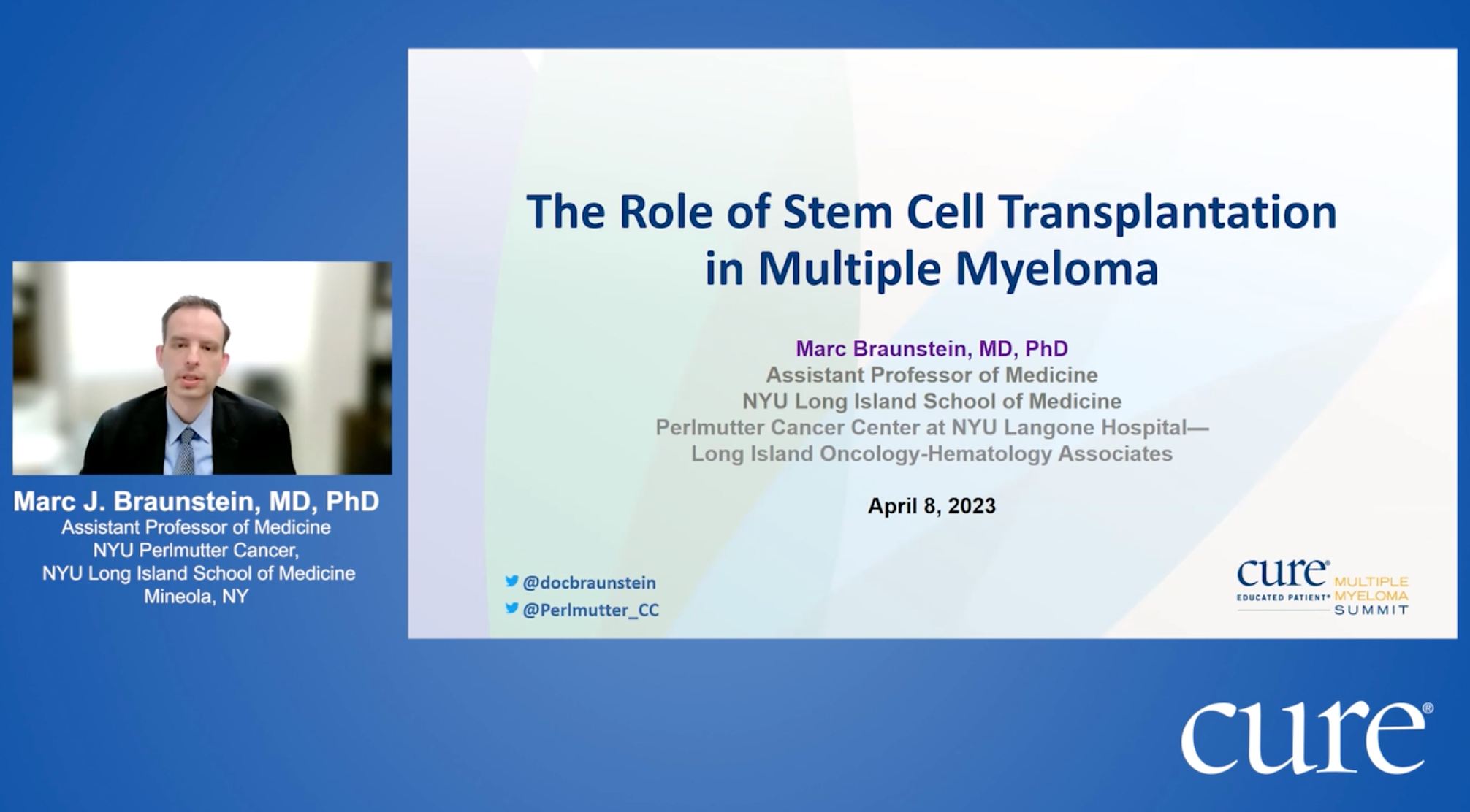Article
Educated Patient® Multiple Myeloma Summit the Role of BMT Presentation: April 8, 2023
Author(s):
Watch Dr. Marc Braunstein, from NYU Langone Hospital, discuss the role of bone marrow transplant during the CURE Educated Patient Multiple Myeloma Summit.
Although high-dose chemotherapy and stem cell transplantation are an integral treatment for fit patients with multiple myeloma after undergoing initial treatment, research is underway to determine whether immunotherapies like CAR-T cell therapies can potentially replace transplants, an expert said.
Even with these ongoing trials, it’s important to note that stem cell transplants are still relatively safe.
“While there can be complications in the short term, even long term from a transplant, it’s generally very safe,” Dr. Marc Braunstein, assistant professor of medicine at NYU Long Island School of Medicine and Perlmutter Cancer Center at NYU Langone Hospital in New York, said in an interview with CURE®. “Until we have data clearly demonstrating a survival advantage of an alternative regimen, perhaps CAR-T cells, transplant still remains a standard of care for consolidation (therapy) of multiple myeloma.”
One expert explained how stem cell transplant can play a role in a patient’s treatment for multiple myeloma and what’s on the horizon.

Braunstein discussed the role of stem cell transplantation in patients with myeloma during the CURE® Educated Patient® Multiple Myeloma Summit.
Undergoing a Stem Cell Transplant
Patients with multiple myeloma typically undergo stem cell transplantation either after induction treatment for newly diagnosed patients, or after second- or third-line treatment following a relapse.
“Stem cell transplantation involves collecting stem cells from blood, putting them into a freezer, giving high-dose chemotherapy typically with a drug called melphalan and then speeding the recovery up by reinfusing the stem cells as a transfusion the following day,” Braunstein said. “This process is intended to remove any residual multiple myeloma cells that may have remained after the initial therapy.”
Studies have found that stem cell transplantation can improve the time to next therapy and eliminate the need for more extensive three- or four-drug treatments during the time after transplant until relapse. Findings from some studies have demonstrated that stem cell transplantation can prolong a patient’s survival time from the disease.
“It has multiple benefits and still has a role even in the setting of modern myeloma therapy,” Braunstein said.
Braunstein added that autologous stem cell transplant (when cells are taking from the patient themselves) is very safe and has a mortality rate of less than 1%. In fact, the transplant is performed in an outpatient setting, where patients have to return to the facility once every day until their bone marrow is restored, which can take up to two or three weeks. Some side effects that may occur during this time include fatigue, nausea, diarrhea and mucositis, which is an irritation of the gastrointestinal tract. Patients during this time may also be more prone to infections, so they may need fluids and an antibiotic regimen.
“It's kind of like a passing storm, things get a little worse, and then they get better as the bone marrow restores, and more of the myeloma is eliminated after the chemotherapy,” Braunstein explained.
Maintaining Benefits of Transplantation
Once a patient undergoes a stem cell transplantation, maintenance therapy becomes a critical component of the process, as it can enhance the effect of the transplant by prolonging survival. Several trials have assessed maintenance therapy with Revlimid (lenalidomide), the most common therapy for this setting, which prolonged survival after transplant in patients with multiple myeloma compared with placebo or no maintenance therapy.
Cancer teams can determine whether a patient can stop maintenance therapy through minimal residual disease, which is a term that describes a very small number of cancer cells in the body after treatment.
“There are emerging studies to say that if someone has sequentially negative (minimal residual disease) tests back-to-back after a certain interval, then you could potentially discontinue the maintenance therapy,” Braunstein said.
Research is being conducted currently to assess different maintenance therapy regimens in addition to different regimens for relapse following stem cell transplantation. This includes findings from recent data that demonstrate that CAR-T cell therapy may be more effective than conventional maintenance therapies.
CAR-T cell therapy may also play a role in treating patients after induction compared with stem cell transplantation, for which research is in progress.
Education to Make Informed Decisions
Braunstein urged patients with multiple myeloma who are determining whether they can undergo a stem cell transplant to be evaluated by a specific transplant doctor to determine their eligibility.
“It's more than just one factor that goes into eligibility for stem cell transplant,” Braunstein said. “So the patient that’s evaluated by a stem cell transplanter may not be the same person as their oncologist. And so just because someone is a more advanced age or even has certain comorbidities, such as kidney dysfunction, does not necessarily make them unfit for transplant.”
He also emphasized the importance of education for patients with multiple myeloma, which allows them to become their own advocate.
“I think the best thing we can do for our patients when we discuss multiple myeloma, their diagnosis, their prognosis, their treatment is to educate them,” Braunstein told CURE. “That's what I really take pleasure at doing when I see a new patient, is to give them the best education I can about the disease so they can be their own advocate, and they can understand what the process is.”
For more news on cancer updates, research and education, don’t forget to subscribe to CURE®’s newsletters here.





